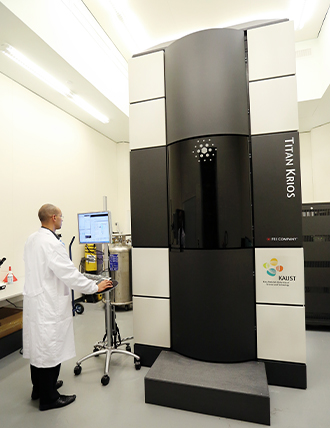KAUST's Core Laboratories and Major Facilities directly support the research mission of the University by providing state-of-the-art research facilities, training and expert services to the KAUST research community. With more than 135 staff scientists, engineers, specialists, technicians and administrators, the Core Labs function as a shared-user facility and play a key role in encouraging interdisciplinary collaboration through ease of access to major equipment and a consistent mode of operation.
NMR Core Facility
.jpg) Nuclear Magnetic Resonance (NMR) and Dynamic Nuclear Polarization (DNP) is an extremely powerful tool for the
Nuclear Magnetic Resonance (NMR) and Dynamic Nuclear Polarization (DNP) is an extremely powerful tool for the .jpg?sfvrsn=2cb6e268_2) identification of chemical composition and the determination of molecular structure. At KAUST, we boast an NMR lab housing five Solid, five liquid State NMR and one DNP spectrometers from Bruker, coupled with a huge range of accessories that allow break-through research. High-resolution NMR provide a range of exquisitely precise tools to characterize well-defined active sites in heterogeneous catalysis. Implementation of high resolution and 2-D solid state NMR techniques helped to identify surface structures at a molecular level, which is key to implementing structure–reactivity relationships and rational developments in heterogeneous catalysis. It is clear that these methods also have the potential for extensive further developments and applications, for example towards understanding more complex systems (complex oxide materials, active sites with paramagnetic or quadrupoles nucleus), probing the dynamics of surface species (access to mobility of active sites), and to monitor the active sites as a function of time.
identification of chemical composition and the determination of molecular structure. At KAUST, we boast an NMR lab housing five Solid, five liquid State NMR and one DNP spectrometers from Bruker, coupled with a huge range of accessories that allow break-through research. High-resolution NMR provide a range of exquisitely precise tools to characterize well-defined active sites in heterogeneous catalysis. Implementation of high resolution and 2-D solid state NMR techniques helped to identify surface structures at a molecular level, which is key to implementing structure–reactivity relationships and rational developments in heterogeneous catalysis. It is clear that these methods also have the potential for extensive further developments and applications, for example towards understanding more complex systems (complex oxide materials, active sites with paramagnetic or quadrupoles nucleus), probing the dynamics of surface species (access to mobility of active sites), and to monitor the active sites as a function of time.
2-D high resolution and 2-D spectra shows the power of this technique to characterize the well-defined heterogeneous catalysts prepared by surface organometallic chemistry.
Electron Microscopy

 The materials science electron microscopy facility houses six top-of-the-line electron microscopes. Several of these microscopes enable sub-angstrom imaging capability and ultra high-energy resolution chemical analysis capability.
The materials science electron microscopy facility houses six top-of-the-line electron microscopes. Several of these microscopes enable sub-angstrom imaging capability and ultra high-energy resolution chemical analysis capability.